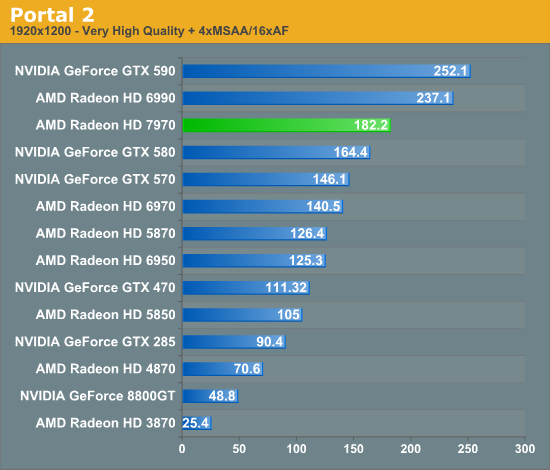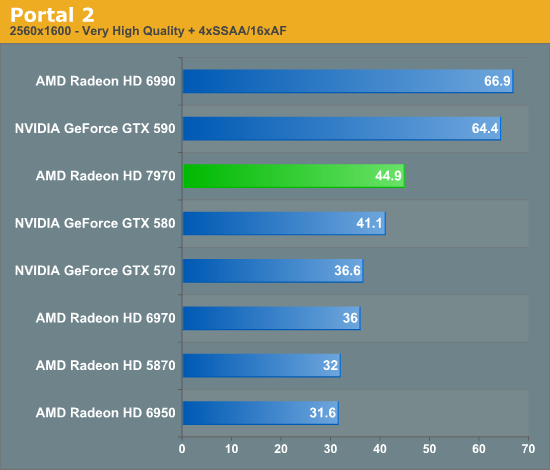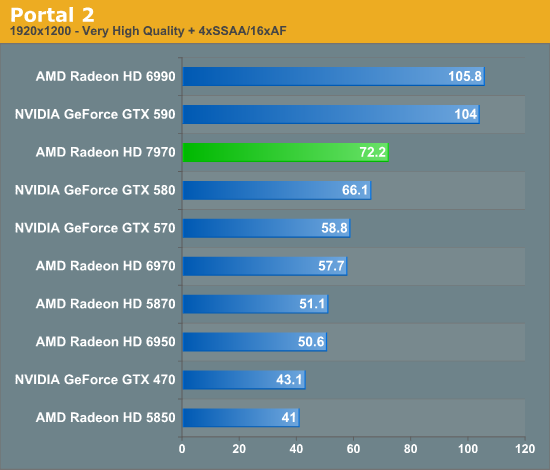AMD Radeon HD 7970 Review: 28nm And Graphics Core Next, Together As One
by Ryan Smith on December 22, 2011 12:00 AM EST- Posted in
- GPUs
- AMD
- Radeon
- ATI
- Radeon HD 7000
Portal 2
Portal 2 continues the long and proud tradition of Valve’s in-house Source engine. While Source continues to be a DX9 engine, Valve has continued to upgrade it over the years to improve its quality, and combined with their choice of style you’d have a hard time telling it’s over 7 years old at this point. Consequently Portal 2’s performance does get rather high on high-end cards, but we have ways of fixing that…


Given Portal 2’s wide range of performance it’s possible to at least somewhat bog it down on the GPU side without any special tricks thanks to its heavier use of shaders than in past Valve titles. Given a fast enough card I believe we could hit the 300fps internal Source framerate cap on our testbed, but thankfully at 2560 we’re nowhere close. In any case at 2560 the 7970 is well into the stratosphere, delivering 128.9fps, which is 18% better than the GTX 580. Meanwhile at 1920 as with so many other benchmarks that lead shrinks, this time down to 11%. Meanwhile the 7970 enjoys a smaller lead over the 6970, beating it by only around 30% at either resolution.


The great thing about the Source engine is that it’s well studied, and by utilizing DirectX9 it’s open to a few more image quality enhancements than DX10+ games. We’ve always wanted to have a standard benchmark with more anti-aliasing than just MSAA, and Portal is the perfect candidate. So for the second part of this test, we’ve turned on Super Sample Anti-Aliasing (SSAA) through NVIDIA and AMD’s driver control panels. With SSAA the entire scene gets anti-aliased, going beyond just removing the jaggies at polygon edges and removing all signs of shader aliasing too, making Portal 2 a very good looking game.
As expected, SSAA makes the performance of everything tank. At 2560 the 7970 is well below 60fps, and every other single-GPU card is slower yet. Once we get down to 1920 performance finally reaches a point where it’s playable, as the 7970 reaches 72.2fps.
Compared to its competition, it’s interesting to note that we appear to have hit an entirely different set of bottlenecks by using SSAA. The 7970 leads the GTX 580 by 9% at both resolutions while it leads the 6970 by 25% under the same conditions. We believe that at this point we’re seeing the limitations of ROP performance, which would explain why the 7970’s lead diminishes versus both the GTX 580 and 6970. The additional bandwidth the 7970’s design affords the ROPs can only go so far until it once again becomes a matter of pixel pushing power.










292 Comments
View All Comments
gevorg - Thursday, December 22, 2011 - link
37.9dB is a horrible testbed for noise testing! WTF!mavere - Thursday, December 22, 2011 - link
Seriously!With the prevalence of practically silent PSUs, efficient tower heatsinks, and large quiet fans, I cannot fathom why the noise floor is 37.9 dB.
Finally - Thursday, December 22, 2011 - link
As usual, AT is shooting straight for the brain-dam, I mean, ENTHUSIAST crowd feat. a non-mentioned power supply that should be well around 1000W in order to drive over-priced CPUs as well as quadruple GPU setups.If you find that horrendous they will offer you not to read this review, but their upcoming HTPC review where they will employ the same 1000W power supply...
B3an - Thursday, December 22, 2011 - link
*face palm*1: 1000+ Watt PSU's are normally more quiet if anything as they're better equipped to deal with higher power loads. When a system like this uses nowhere near the PSU's full power the fan often spins at a very low RPM. Some 1000+ PSU's will just shut the fan off completely when a system uses less than 30% of it's power.
2: It's totally normal for a system to be around 40 dB without including the graphics cards. Two or 3 fans alone normally cause this much noise even if they're large low RPM fans. Then you have noise levels from surroundings which even in a "quiet" room are normally more than 15 dB.
3: Grow some fucking brain cells kids.
andymcca - Thursday, December 22, 2011 - link
1) If you were a quiet computing enthusiast, you would know that the statement"1000+ Watt PSU's are normally more quiet if anything"
is patently false. 1000W PSUs are necessarily less efficient at realistic loads (<600W at full load in single GPU systems). This is a trade-off of optimizing for efficiency at high wattages. There is no free lunch in power electronics. Lower efficiency yields more heat yields more noise, all else being equal. And I assure you that a high end silent/quiet PSU is designed for low air flow and uses components at least as high in quality as their higher wattage (non-silent/non-quiet) competitors. Since the PSU is not decribed (a problem which has been brought up many times in the past concerning AT reviews), who knows?
2) 40dB is fairly loud if you are aiming for quiet operation. Ambient noise in a quiet room can be roughly 20dB (provided there is not a lot of ambient outdoor noise). 40dB is roughly the amplitude of conversation in a quiet room (non-whispered). A computer that hums as loud as I talk is pretty loud! I'm not sure if you opinion is informed by any empirical experience, but for precise comparison of different sources the floor should be at minimum 20dB below the sources in question.
3) You have no idea what the parent's age or background is, but your comment #3 certainly implies something about your maturity.
formulav8 - Tuesday, February 21, 2012 - link
Seriously grow up. Your a nasty mouth as well.piroroadkill - Thursday, December 22, 2011 - link
Haha, yeah.Still, I guess we have to leave that work to SPCR.
Kjella - Thursday, December 22, 2011 - link
High-end graphics cards are even noisier, so who cares? A 250W card won't be quiet no matter what. Using an overclocked Intel Core i7 3960X is obviously so the benchmarks won't be CPU limited, not to make a quiet PC.Ryan Smith - Thursday, December 22, 2011 - link
Our testing methodology only has us inches from the case (an open case I should add), hence the noise from our H100 closed loop radiator makes itself known. In any case these numbers aren't meant to be absolutes, we only use them on a relative basis.MadMan007 - Thursday, December 22, 2011 - link
[AES chart] on page 7?